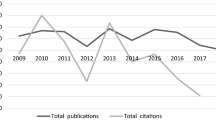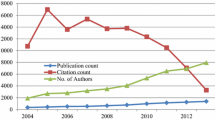Abstract
It is widely accepted that biotechnology is a globally significant and growing research field. Because of its biodiversity, Colombia has a comparative advantage to innovate and commercialize biotechnological products and services. The aim of this study is to obtain a research profile and intellectual structure of the country in the biotechnology field by using bibliometric methods. These methods are needed to monitor the capacities and the compliance of national policies in biotechnology. By using records extracted from the ISI WoK database, this study describes the biotechnology publication trend, productivity and collaboration among institutions and countries, preferred journals, and the intellectual structure at the research subject area. Although, a growing trend in biotechnology publication was observed, the productivity is still low when compared to other countries in the region and the world. On the other hand, researchers seem to show a preference for international over domestic collaboration. The results suggest two elements: first, policy has not had the expected outcome in the short term, and second, a lack of internal collaboration could therefore reflect low endogenous capacities. The bibliometric methods used in this study can be applied to a wide range of research fields other than biotechnology.



Similar content being viewed by others
Notes
Records per capita are calculated based on the country population and have an order of magnitude of 10−6. The information was consulted the 29th of March (2014) on the website of the World Bank http://datos.bancomundial.org/indicador/SP.POP.TOTL. We thank a reviewer for this suggestion.
Argentina, Brazil, Mexico, Chile, Peru, Venezuela, Costa Rica, and Ecuador.
In Fig. 2b are observed only the top 30 countries. This avoids the clutter in the figure and improves its understanding.
Universities in Colombia are Higher Education Institutions classified according to their legal nature in public and private institutions. The private universities should be organized as legal entities of public utility, nonprofit, organized as corporations, foundations and institutions of solidarity economy. Public universities have special autonomy in terms of recruitment, special regime to pay their teachers, special handling in budgetary matters, and have special contributions to be maintained by the National Government.
International Center for Tropical Agriculture. Although, the CIAT has its headquarters in Colombia, its impact is wider involving more than 200 scientist working in Latin America and the Caribbean as well as 29 countries in sub-Saharan Africa and 5 in South East Asia.
High Council of Scientific Research. CSIC is the main public research institution in Spain. This institution coordinates, develops, and diffuses the research and technology towards knowledge generation and economic development. One of their main functions is the diffusion and contribution of the Spanish research at the international landscape.
References
Aksnes, D. W., Olsen, T. B., & Seglen, P. O. (2000). Validation of bibliometric indicators in the field of microbiology: A Norwegian case study. Scientometrics, 49(1), 7–22.
Arvanitis, R., Waast, R., & Gaillard, J. (2000). Science in Africa: A bibliometric Panorama using PASCAL database. Scientometrics, 47(3), 457–473.
Asknes, D. W., & Taxt, R. E. (2004). Peers reviews and bibliometric indicators: A comparative study at Norwegian University. Research Evaluation, 21(1), 33–41.
Bajwa, R. S., & Yaldram, K. (2013). Bibliometric analysis of biotechnology research in Pakistan. Scientometrics, 95, 529–540.
Bayer, E. A., & Folger, J. (1996). Some correlates of a citation measure of productivity in science. Sociology of Education, 39(4), 381–390.
Braun, T., Schubert, A. P., & Kostoff, R. N. (2000). Growth and trends of fullerene research as reflected in its journal literature. Chemical Reviews, 100(1), 23–38.
Chen, K., & Guan, J. (2011). A bibliometric investigation of research performance in emerging nanobiopharmaceuticals. Journal of Informetrics, 5(2), 233–247.
COLCIENCIAS (2008). Colombia siembra futuro: Política Nacional de Fomento a la Investigación y la Innovación. Bogotá.
Dannenberg, A. L. (1985). Use of epidemiology in medical specialties: An examination by citation analysis. American Journal of Epidemiology, 121(1), 140–151.
Davis, J. C., & Gonzalez, J. C. (2003). Scholarly journal articles about the Asian Tiger Economies: Authors, journals and research fields, 1986–2001. Asian-Pacific Economic Literature, 17(2), 51–61.
DNP (2009). Política Nacional de Ciencia, Tecnología e Innovación. (Conpes-3582). Bogotá.
DNP (2011). Política para el desarrollo comercial de la biotecnología a partir del uso sostenible de la biodiversidad. (Conpes-3697). Bogotá.
Estrabooks, C. A., Winther, C., & Derksen, L. (2004). Mapping the field: A bibliometric analysis of the research utilization literature in nursing. Nursing Research, 53(5), 293–303.
Etzkowitz, H., & Leydesdorff, L. (2000). The dynamics of innovation: From National Systems and “Mode 2” to a Triple Helix of university–industry–government relations. Research Policy, 29(2), 109–123.
Frenken, K., Holzl, W., & Vor, F. (2005). The citation impact of research collaborations: The case of European biotechnology e applied microbiology (1998–2002). Journal of Engineering Management and Technology, 22(1–2), 9–30.
Furman, J. L., Porter, M. E., & Stern, S. (2002). The determinants of national innovative capacity. Research Policy, 31(6), 899–933.
Gaulthier, E. (1998). Bibliometric analysis of scientific and technological research: A user’s guide to the methodology. Observatoire des Sciences et des Technologies (CIRST): Science and Technology Redesign Project.
Gay, B., & Dousset, B. (2005). Innovation and network structural dynamics: Study of the alliance network of a major sector of the biotechnology industry. Research Policy, 34(10), 1457–1475.
Glanzel, W., & Zhow, P. (2011). Publication activity, citation impact and bi-directional links between publications and patents in biotechnology. Scientometrics, 86(2), 505–525.
Gomez-Costa, B. M., Silva-Pedro, E., & Ribeiro-de-Macedo, G. (2013). Scientific collaboration in biotechnology: The case of the northeast region in Brazil. Scientometrics, 95(2), 571–592.
Hawkins, D. T. (1977). Unconventional uses of on-line information retrieval systems: On-line bibliometric studies. Journal of the American Society for Information Science, 28(1), 13–18.
Jacobs, D., & Ingwersen, P. (2000). A bibliometric study of the publication patterns in the sciences of south African Scholars 1981–96. Scientometrics, 47(1), 75–93.
Jeong, S., & Kim, H. G. (2010). Intellectual structure of biomedical informatics reflected in scholarly events. Scientometrics, 85(2), 541–551.
Junquera, B., & Mitre, M. (2007). Value of bibliometric analysis for research policy: A case study of Spanish research into innovation and technology management. Scientometrics, 71(3), 443–454.
Kim, M. J. (2007). A bibliometric analysis of the effectiveness of Korea’s Biotechnology Stimulation Plans, with a comparison with other four Asian nations. Scientometrics, 72(3), 371–388.
Krampen, G., von Eye, A., & Schui, G. (2012). Forecasting trends of development of psychology from a bibliometric perspective. Scientometrics, 87(3), 687–694.
Kumar, P. S., & Chand, P. (2005). Biotechnology research profile of India. Scientometrics, 63(3), 583–597.
Leydesdorff, L., & Gauthier, E. (1996). The evaluation of national performance in selected priority areas using scientometric methods. Research Policy, 25(3), 431–450.
Li, L., Ding, G., Feng, N., Wang, M., & Ho, Y. (2008). Global stem cell research trend: Bibliometric analysis as a tool for mapping of trends from 1991 to 2006. Scientometrics, 80(1), 39–58.
Martinez, H., Jaime, A., & Camacho, J. (2012). Relative absorptive capacity: A research profiling. Scientometrics, 92(3), 657–674.
McCain, K. W. (1995). The structure of biotechnology R & D. Scientometrics, 32(2), 153–175.
McMillan, G., Narin, F., & Deeds, D. L. (2000). An analysis of the critical role of public science in innovation: The case of biotechnology. Research Policy, 29(1), 1–8.
Molatudi, M., & Pouris, A. (2006). Assesing the knowledge base for biotechnology in South Africa—a bibliometric analysis of South African microbiology and molecular biology and genetics research. Scientometrics, 68(1), 97–108.
Novak, J. D. (2010). Earning, creating, and using knowledge: Concept maps as facilitative tools in schools and cooperations (2nd ed.). New York: Taylor & Francis.
OECD (2011). Biotechnology R&D OECD science, technology and industry scoreboard 2011. Paris: OECD Publishing.
OECD (2013). OECD patent database, October 2013. Retrieved the 14th of March of 2014. http://www.oecd.org/innovation/inno/keybiotechnologyindicators.htm.
Pritchar, A. (1969). Statistical bibliography or bibliometrics. Journal of Documentation, 25(4), 348–349.
Rahman, M., Haque, T. L., & Fukui, T. (2005). Research articles published in clinical radiology journals: Trend of contribution from different countries. Academic Radiology, 12(7), 825–829.
Rajendram, R., Lewison, G., & Preedy, V. R. (2006). Worldwide alcohol-related research and the disease burden. Alcohol and Alcoholism, 41(1), 99–106.
Schummer, J. (2007). The global institutionalization of nanotechnology research: A bibliometric approach to the assessment of science policy. Scientometrics, 70(3), 669–692.
Senthilkumaran, P., & Amudhavalli, A. (2007). Mapping of spices research in Asian countries. Scientometrics, 73(2), 149–159.
Shaw, M. W. (1993). The biodiversity of microorganisms and invertebrates: Its role in sustainable agriculture. Experimental Agriculture, 29(1), 133.
Smith, K. (1994). Interactions in knowledge systems: Foundations, policy implications and empirical methods. STEP Report.
Su, H.-N., & Lee, P.-C. (2010). Mapping knowledge structure by keyword co-occurrence: A first look at journal papers in Technology Foresight. Scientometrics, 85(1), 65–79.
Yuthavong, Y. (1986). Bibliometric indicators of scientific activity in Thailand. Scientometrics, 9(3–4), 139–143.
Zhang, W., Qian, W., & Ho, Y. (2009). A bibliometric analysis of research related to ocean circulation. Scientometrics, 80(2), 305–316.
Zilberman, D., Ameden, H., Graff, G., & Qaim, M. (2004). Agricultural biotechnology: Productivity, biodiversity, and intellectual property rights. Journal of Agricultural & Food Industrial Organization, 2(3), 1–16.
Acknowledgments
The authors would like to thank the reviewers of this paper for making many valuable suggestions and thoughtful comments. Besides, we thank Professors Luis E. Becerra and Piedad Arenas for their valuable feedback. We also thank the Universidad Industrial de Santander for its support in the provision of specialized analytic tools (software) needed to obtain the data.
Author information
Authors and Affiliations
Corresponding author
Rights and permissions
About this article
Cite this article
Martinez, H., Jaime, A. & Camacho, J. Biotechnology profile analysis in Colombia. Scientometrics 101, 1789–1804 (2014). https://doi.org/10.1007/s11192-014-1408-2
Received:
Published:
Issue Date:
DOI: https://doi.org/10.1007/s11192-014-1408-2




